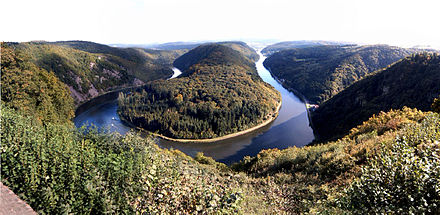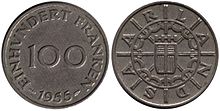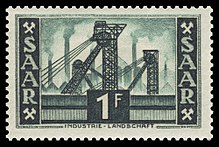Saarland
![]()
This article is about the federal state of Saarland. For the protectorate state of Saarland, see Saarland 1947 to 1956; for the League of Nations mandate existing from 1920 to 1935, see Saarland.
The Saarland [ˈzaːɐ̯lantʰ] (French la Sarre, abbreviation SL) is a state in the southwest of the Federal Republic of Germany. The smallest of the Flächenländer and, in terms of population, the second smallest state (after Bremen) with just under one million inhabitants, it borders the state of Rhineland-Palatinate to the north and east, the French region of Grand Est to the south, where it borders the Département Moselle, and the Grand Duchy of Luxembourg to the west. Together with these neighbours and the Belgian region of Wallonia, Saarland forms the European greater region of Saar-Lor-Lux, which is home to around 11.6 million people.
Saarland is characterised by a high degree of industrialisation and a strongly developed infrastructure. The region has the highest cross-border mobility of workers in the European Union. The state capital, largest city and regional centre of Saarland is Saarbrücken.
After administrative and constitutional predecessors since the 7th century (Frankish Gaugrafschaft Saargau) and the 17th century (Duchy of Saarland, Saar Province and Saar Department), the Saarland came into being on 10 January 1920 as the political unit Saar(becken)gebiet (Territoire du Bassin de la Sarre) as a result of the Treaty of Versailles. It was separated from the state authority of the German Reich and existed for 15 years with its own constitution and with the international government commission appointed by the League of Nations Council as a League of Nations mandate, under the first assurance of a state-legal independent existence. At the insistence of the population, a regional council was set up in 1922 as an advisory representation of the people. In 1935, following the Saar referendum provided for in the treaty, the Saar region was reincorporated into the German Reich as the Reichsland Saarland, at that time under National Socialist leadership, on the basis of around 90 percent approval.
After the Second World War, the Saarland became part of the French occupation zone following the creation of the Saar Regional Council. France subsequently hived it off and removed it from the jurisdiction of the Allied Control Council. A separate state government and the enactment of the Saarland constitution on 15 December 1947 aimed to create a formally autonomous Saar state. However, constitutional autonomy, self-government and self-administration were limited by French suzerainty. The Saarland was an associate member of the Council of Europe from 1950. In the following year, 1951, it joined the European Coal and Steel Community (Coal and Steel Community) as part of the Saarland-French Economic Community. After the rejection of the European Statute for the Saarland in a referendum on 23 October 1955, there was a partial revision of the constitution as well as new negotiations, after which the Saarland politically joined the Federal Republic of Germany on 1 January 1957 as the 11th federal state. The full economic accession took place on 6 July 1959 (popularly known as "Day X").
Geography
Location
The Saarland is located in the extreme southwest of Germany. It covers parts of the Hunsrück with the Black Forest, the Lorraine strata and the Saar-Nahe mountain region. With an area of 2,569.69 square kilometres, it has established itself in the German-speaking world as a benchmark for medium-sized disaster events, such as forest fires or floods. Other important areas are the Saar and Bliesgau with their fertile limestone soils.
Geology
The Saarland shows a high heterogeneity both geologically and geomorphologically. The Saarbrücker Sattel, which is bedded from northeast to southwest and in which Carboniferous rocks come to the surface, adjoins sedimentary and magmatic rocks of the Permian to the north and northeast. Bordering these Permian rocks to the north is the Hunsrück, which forms the southern margin of the Rhenish Slate Mountains. To the northeast, the Permian rocks border the Mainz Basin, a lateral extension of the tectonically formed Upper Rhine Plain. The Saarbrücken Saddle is bordered in the south, southeast and west by Triassic rocks that are unevenly bedded to each other. Deposits from the Triassic fill the Saargemünd-Zweibrück trough in the southeast of the Saarland. To the southeast they merge into the red sandstone mountains of the Vosges and to the east into the Palatinate Forest. In the west and southwest of the Triassic areas of the Saarland are deposits of the Paris Basin from the younger Mesozoic.
Surveys
The highest elevation is the Dollberg (695.4 m) north of Nonnweiler, the second highest is the Schimmelkopf (694.8 m) north of Weiskirchen. The most important elevation, however, is the Schaumberg in Tholey with its lookout tower, which is considered the local mountain of the Saarland, probably due to its tradition as the highest mountain of the former Saar region. It is relatively low at 569 metres, but stands alone in a rather flat environment.
Vegetation
One third of the area of Saarland is covered with deciduous mixed forest. This means that Saarland, together with Hesse and Rhineland-Palatinate, has the largest forest area in Germany in percentage terms. In addition, deciduous forest takes up the largest share of the total forest area here compared to all other federal states.
Waters
The longest river in Saarland is the Blies, of whose 99.5 km of course lie in the state, whereas only 68 km of the course of the eponymous Saar lie in the state. The Blies rises in the northern Saarland near Selbach and flows into the Saar in the south as a border river near Saargemünd (France). Other important rivers are the Moselle, Prims, Nied, Nahe and Rossel. In the north there are also the Bostalsee and the Losheimer Stausee.
Almost 95 % of the area of Saarland belongs to the catchment area of the Saar-Moselle river system. The remaining 5 % of the state's territory in the northeast belonged to the Glan-Nahe drainage area.
See also: List of lakes in Saarland
Climate and precipitation
The climate is temperate oceanic. The average annual precipitation is 800 millimeters. The Saarland is one of the warmest regions in Germany.
![]()
Commons: Precipitation graphs - Collection of images, videos and audio files
Landscapes
In addition to the political division into municipalities and into the Saarland districts, the following landscapes and areas can be described. They are characterized by a relatively uniform appearance in demarcation to neighboring landscapes and areas, which often arose from common political-historical or economic contexts (especially agriculture, industrialization):
- Bliesgau
- Köllertal
- Eastern Valley
- Saargau
- Saar Coal Forest
- Black Forest
- Sankt Ingbert-Kirkel forest area
- St. Ingbert Valley
- Saint Wendel region
- Warndt
See also: List of natural units in Saarland

One of the landmarks of the Saarland: Saarschleife near Mettlach
History
→ Main article: History of the Saarland
→ Main article: Duchy of Saarland
→ Main article: Province de la Sarre
→ Main article: Département de la Sarre
→ Main article: Saar region
→ Main article: Saarland 1947 to 1956
Today's Saarland was formed as a political entity on January 10, 1920, after administrative and constitutional predecessors in the early Middle Ages and early modern times, from areas that had belonged to the Prussian or Bavarian territories since the Congress of Vienna.
After the Second World War and even before the founding of the state of Rhineland-Palatinate on August 30, 1946, 142 municipalities with just under 900 square kilometers and around 100,000 inhabitants were separated from the administrative district of Trier and annexed to the Saarland on August 1, 1946, extending the Saarland's territory to the Hunsrück and the Moselle. Less than a year later, however, on June 8, 1947, the French government had to take into account the opposition of the governments of the United States and Great Britain to this unilateral territorial change and return 61 municipalities of the Saarburg and Trier districts. However, areas of the expansion of August 1, 1946 in the northeast that had been part of the Grand Duchy of Oldenburg (exclave of the Principality of Birkenfeld) and the Duchy of Saxe-Coburg and Gotha (Principality of Lichtenberg) in the 19th century, as well as the border area to the Grand Duchy of Luxembourg in the northwest, remained with the Saarland. In addition, on June 8, 1947, the Saarland territory was expanded in the northeast to include 13 Rhineland-Palatinate municipalities. In the east of the Saarland, small territorial parts of Rhineland-Palatinate were added on 23 April 1949.
In the time before the French Revolution, the four most important dominions in the area of today's Saarland were the Electorate of Trier, the Duchy of Lorraine, the Wittelsbach Duchy of Palatinate-Zweibrücken and the County of Saarbrücken. These four dominions are also reflected in today's coat of arms.
The independent territories in the area of today's Saarland before the French Revolution had always been German-speaking since the early Middle Ages, but were always temporarily under French influence, especially in the late 17th century during the French Reunions and in the period between the Coalition Wars and the Second Peace of Paris.
Even after the First World War and the Second World War, the country was under French influence. From 1920 to 1935, the "Saargebiet" (as it was then called) was under the administration of the League of Nations, but belonged to the French economic area. On 1 March 1935, following a referendum, the Saar region became part of the German Reich again, initially under the name Saarland.
After the Second World War, the Saarland initially belonged to the French occupation zone before being removed from the jurisdiction of the Allied Control Council in January 1946. In 1947, its own constitution and citizenship were created. The Saarland was briefly given its own currency, the Saar-Mark, on 16 June 1947 for monetary reasons. It was replaced by the French franc on 20 November 1947. It also minted its own coins with German inscriptions and Saarland-related motifs, but these were denominated in French francs (see illustration). Once again, the Saarlanders held a special position for over a decade. This time they also participated with their own teams in the 1952 Summer Olympics as well as in the qualification for the 1954 World Cup.
On October 23, 1955, a referendum was held on the Europeanization of the Saarland, in which 67.7 percent of the voting Saarlanders said "no", thus opposing the (second) Saar Statute negotiated by the Adenauer government with the French government. The result of the vote was interpreted as the will of the Saarland population to join the Federal Republic of Germany. The French government relented, and on 27 October 1956 the Saar Treaty was concluded in Luxembourg, whereupon the Saarland became the tenth federal state of the Federal Republic of Germany on 1 January 1957. The economic annexation, including the adoption of the Deutschmark, was completed on 6 July 1959, the so-called "Day X".
In 2012, Saarland applied for its own top level domain .saarland as part of the application process for new generic top level domains (gTLD), which was awarded to dotSaarland GmbH in September 2014. The project is supported by the government of Saarland, which was able to reserve domain names for free. In addition, the non-profit association dotSaarland e.V. supports the TLD. Besides Saarland, the federal states of Bavaria, Berlin, Hamburg and NRW have their own TLDs.

100 Saar francs from 1955

The mining and steel industry was formative for the country's recent history: Towers and blast furnaces on a stamp from 1953
Questions and Answers
Q: What is Saarland?
A: Saarland is a state (Bundesland) of Germany.
Q: How big is Saarland?
A: Saarland has an area of 2,568.45 km2 (991.7 sq mi).
Q: How many people live in Saarland?
A: As of 2011, there were 1,014,000 people living in Saarland.
Q: Where is Saarland located?
A: Saarland is located in the south-west of Germany and is near the French border and Metz.
Q: What is the capital of Saarland?
A: The capital of Saarland is Saarbrücken.
Q: How do you pronounce Saarland?
A: Saarland is pronounced as /ˈsɑːrlænd/ or /ˈzɑːr-/ in the US, [ˈzaːɐ̯lant] in German (listen), Sarre [saʁ] in French, and Saarlond in Rhine Franconian.
Q: What language is spoken in Saarland?
A: German is the official language of Saarland, but some people may speak French or Rhine Franconian dialects.
Search within the encyclopedia